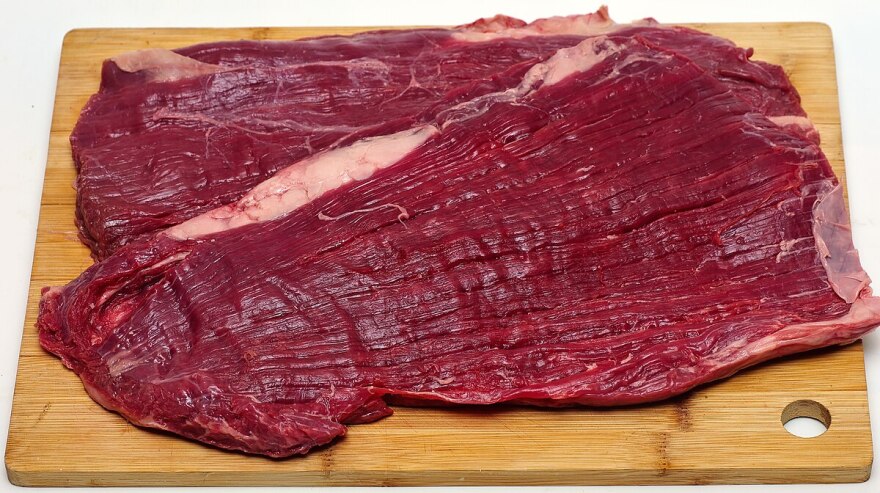Grilling season is in full swing and there is one cut of beef that does extremely well on the grill and that’s flank steak. Maryland farmers who raise beef will always have some of this delicious cut on hand, and if you haven’t tried it, you ought to. And as Chef Jerry Pellegrino has pointed out, grilling a flank steak does require a little bit of savvy.
Flank steak comes from the lower abdomen of the cow. It’s a long, thin, flat piece of meat that can be very chewy if not properly prepared. At the market, it comes rolled up and when you get it home, you’ll find that it’s between 12” and 18” long and about 5” wide.
The first thing I’d do is check to see if there is any “silver skin” membrane. This whitish semi-transparent tissue sits tightly on top of the meat. If you don’t cut it off, it will shrink dramatically when cooked, compressing the meat and making it even tougher. Just use a long very sharp knife to cut it away, or at the very least, score it vigorously.
That being done, you may want to cut the flank steak in two for easy handling.
The next thing we want to do is tenderize the meat with a marinade. First, I advise pricking the steak with a fork, to allow for greater penetration of the liquid. Then you’ll want to prepare a combination of oil, acid, and seasoning. A typical marinade might include olive oil, red wine vinegar, soy sauce, minced garlic, Dijon mustard and black pepper. I find it easy to pour the marinade into a large sealable plastic bag and pop the flank steak in. Leave it in the refrigerator for at least two hours; overnight if you can manage. And move it around for even soaking.
To cook, take the steaks out of the marinade and wipe them down with a paper towel.
Get them as dry as you can, then season with salt and a lot of black pepper. (Remember, a wet steak will steam not sear.)
If you have a grill, fire it up and get a good hot corner going. If you can cook with wood chips, so much the better. Place the steaks on the grill and check your watch. You’ll only need about 3 minutes on each side to get it up to 135°, or medium rare. And make no mistake: this is a meat that needs to be pink on the inside.
Traditionally, we cut the flank steak cross the grain into half inch thick slices. If you know how to whip up a chimichurri sauce, this is the time to do it. But it will go well with just about any standard beef sauce.
Flank steak also makes an appearance when you cut it up and serve it as a taco, quesadilla, or fajita. It also can be given an Asian treatment by preparing pepper steak with a tangy, slightly sweet sauce. An alternative would be to prepare chopped up flank steak with sesame and broccoli, a Chinese classic.
If you’re tempted to try flank steak, you’ll be pleased to find that it is one of the less expensive cuts of beef. And luckily for us, Maryland farmers have plenty on hand.





